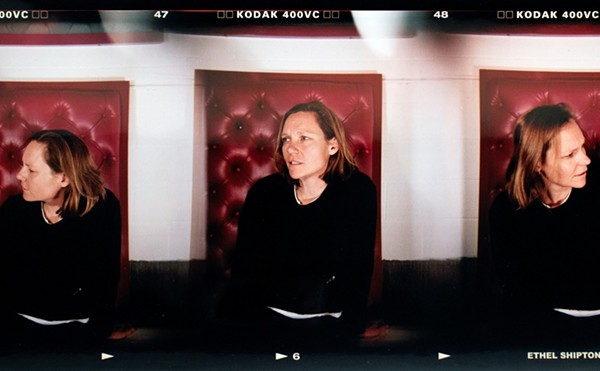| Showgirls, as interpreted by Jayne Lawrence’s wire-frame banana dancers, at Galería Ortiz. |
I visited the exhibit last week with Trinity University professor (and Current contributor) Char Miller, who will give two presentations this month placing Welty’s work in social and historical context. As we stood before “Ruins of Windsor, near Port Gibson,” a 1936 image of a former plantation home ringed in ionic columns, Miller commented that images from the era are preoccupied with loss, but he suggests the ghost of that earlier catastrophe, the Civil War, is what really haunts Welty and other Southern artists of the period. He pointed out the author’s shadow protruding from the bottom of the frame, an unusual intrusion. Welty’s many beautiful photos of African Americans in a segregated nation might be a form of penance, he suggested. Two images, hung side by side in this iteration of the exhibit bring the underlying politics home: a white matron, decked in political ribbons and standing outside a grand building stares out from one photo; to her right, in another frame, an equally proud African-American woman of similar age stands in a yard on a simple farm. What separates their fates but laws designed to favor one over the other?
So passion became the frame for a weekend of art viewing, beginning with the Say Sí student show, Dualities, at Blue Star (1414 S. Alamo, Saysi.org), where the students have used Photoshop filters and manual manipulation to color and distort their hometown photos (single editions only, and priced to sell).
The photographers range in age from 13-17, and while some of the work is clearly amateur, other prints will surprise you with their sophistication and feeling for their subjects. “Underground Art,” a diptych by Ruth Mimi, changes the dark abyss of a graffitied drainage pipe into a glowing beacon of hope. Jude Gil adds a surreal touch to a photo of the Blue Star silos viewed from across the San Antonio River. And in “Chromed Desktop,” Everardo Cruz Gonzalez creates a futuristic metallic landscape out of what looks to have been a still life composed with anachronistic objects. I was also drawn to Tania Soto’s simple diptych of King William townhomes; in the bottom frame they waver, fade, and melt, a reminder of the historic neighborhood’s cycle of decline and renewal, and of the changing populations that pass through it.
Just across Rue Bernard at the UTSA Satellite Space, a more thoroughly realized tribute to San Antonio’s natural environment employs the painstaking collotype method of photographic printmaking, which uses glass plates, lithographic inks, and a press (115 Blue Star, 458-4389). “Japanese Tea Garden,” by Rose Harms, is an accordion-fold book of collotype images of the Japanese Sunken Garden at Brackenridge taken in November 1990 and excerpts from Okakura Kazuko’s 1913 Book of Tea. “Infinity is the Fleeting, the Fleeting is the Vanishing, the Vanishing is the Reverting,” reads one passage, all the more moving given the gardens’ slow decline during the last decade and the renovations now underway.
A park needs treats for the kiddies, of course, and Angela Franks’s “From Balloons” obliges, with close-up photos of knotted and massed sausage balloons (the kind used to make animals). Her work, toeing the line between abstract and figurative with a touch of surreal, leads us to my favorite show of the week which, I confess, is not photography. And if it shows passion for its subject, that subject is the interior landscape of Jayne Lawrence. Last year at REM Gallery, Lawrence showed a collection of small, ceramic, anthropomorphic fruit: flying apples and pears with tiny wings; dancing bananas, some with orifices in strange places. They were enchanting and disturbing and could overwhelm you in swarms. Now, in the wake of a sculpture residency in New York, come lifesize, wire-frame banana dancers in high heels, squatting, lunging, quivering a little in your wake (the wings are articulated), and threateningly, androgynously sexual in the manner of the MC from Cabaret (on view at Galería Ortiz, 4026 McCullough, 826-8623). Strange and mesmerizing creatures they are, and a sturdy bridge to some of the artist’s earlier sculptural work that dealt with forms, uniforms, and assigned roles.

















